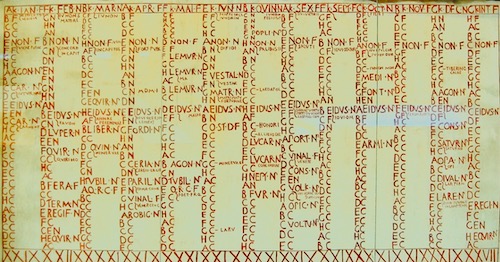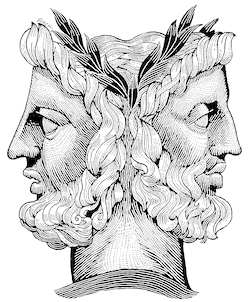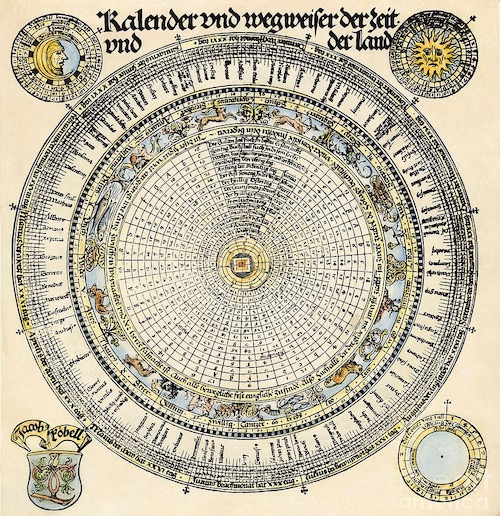 Julius Caesar had spent several years in Egypt with Cleopatra (c. 48-47 BC). They had a son called Caesarian. The Roman AUC (Ad Urbe Condita—“the Founding of the City” of Rome) calendar had been so inaccurate that even though Caesar had crossed the Rubicon on January 10, 49 BC, several years later that date fell in mid-Autumn.
Julius Caesar had spent several years in Egypt with Cleopatra (c. 48-47 BC). They had a son called Caesarian. The Roman AUC (Ad Urbe Condita—“the Founding of the City” of Rome) calendar had been so inaccurate that even though Caesar had crossed the Rubicon on January 10, 49 BC, several years later that date fell in mid-Autumn.
When he returned to Rome, Caesar initiated the Egyptian calendar in 45 BC. It was a simple one of 365 days with an extra day (an intercalary leap year day) every fourth year in order to make up for the drift of the vernal equinox.

 Caesar wanted the new calendar to begin with his rule, but the Senate had always started a new year on January 1, the month named after the god Janus (right) who had two faces, one looking ahead to the future and the other looking back to the past. The Senate won that fight and modern New Years always commence on January 1.
Caesar wanted the new calendar to begin with his rule, but the Senate had always started a new year on January 1, the month named after the god Janus (right) who had two faces, one looking ahead to the future and the other looking back to the past. The Senate won that fight and modern New Years always commence on January 1.
The Julian calendar (named after Julius Caesar) and its ease of use were an immediate success in the Roman world. Only nine years after its initiation, the Roman scholar and writer Varro (116-27 BC) was using the system to fix dates for the start of seasons.
Within a hundred years after its introduction, the Julian calendar was the staple of time in the Roman Empire and would be used by the civil world for almost 1,600 years.

But the Christian Church had for centuries used a different calendar for its main celebration, Easter aka Pascha (meaning “Passover”). The Church Calendar, based on a lunar system, had been devised at The First Council of Nicea in 325 to ensure the Church celebrated Easter on the exact Sunday of the Resurrection. The Church in Alexandria had always celebrated Easter on the 14th day of the moon that falls on or after the vernal equinox. By the 900’s most Christian churches celebrated Easter according to the Alexandrine method. But the vernal equinox drifts. By the 1500’s the lunar calendar was off and Easter was being celebrated on the wrong day.
 Pope Gregory XIII (left) and the learned ecclesiastics were determined to fix the problem of equinox drift and the confusion over the date of Easter once and for all. To remedy the drift problem, the Gregorian calendar dropped 10 days from the year 1582. On Thursday October 4, 1582 the Church adopted what would be called the Gregorian calendar by a papal bull entitled Inter Gravissimas (”Among The Greatest Concern”).
Pope Gregory XIII (left) and the learned ecclesiastics were determined to fix the problem of equinox drift and the confusion over the date of Easter once and for all. To remedy the drift problem, the Gregorian calendar dropped 10 days from the year 1582. On Thursday October 4, 1582 the Church adopted what would be called the Gregorian calendar by a papal bull entitled Inter Gravissimas (”Among The Greatest Concern”).
The Christian Church may have had grave concerns about the date of Easter being astronomically inaccurate on the church lunar and Julian solar calendars, but the secular world was not obligated by a papal bull.
The Catholic countries of Spain, Italy, Portugal and the Polish-Lithuanian Commonwealth, however, adopted the new calendar immediately. Scotland and most Protestant countries adopted Gregory’s calendar in the 1700’s. England and colonial America adopted it in 1752. When Alaska was purchased by the United States from Russia in 1867, the Alaska Territory began to keep Gregorian time. Russia remained on the Julian calendar until 1917 after the Russian Revolution and Greece held on to Julian until 1923. Some tribes and isolated peoples still use the Julian calendar. Today, internationally, the Gregorian calendar is the only one used. It is so accurate it has an infinitesimal error of gaining only one day every 3,325 years. The Christian concern over the date of Easter has prevailed even though most of the secular world had no idea there had been a problem.
Calendars were traditionally invented and used to facilitate agricultural plantings and harvests, religious events, the start of seasons, tribal migrations and to chronicle the past. But since the advent of Jesus of Nazareth, the Christian Western world has been fixated on refining and correctly ascertaining the exact Sunday in each year when Christians are to celebrate His Resurrection. Countries with no Christian backgrounds have recognized the Gregorian calendar. Japan adopted it January 1, 1873; Korea on January 1, 1895 and China in 1912. It may be for some an uncomfortable reality, but it is true that for over 2,000 years the world has had to reckon with a young Jewish rabbi who taught, lived, died and, according to His followers and their Bible, resurrected from the dead. The dates on our 21st century calendars are reckoned from Him.—Article by Sandra Sweeny Silver 
